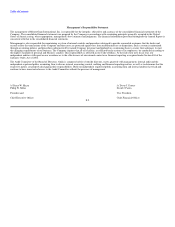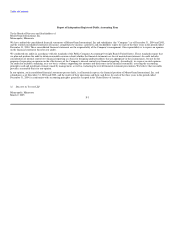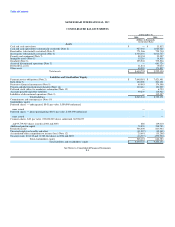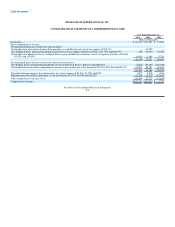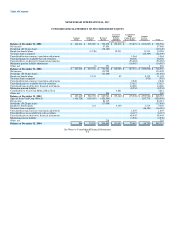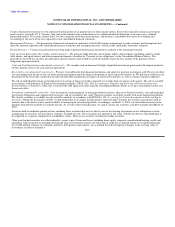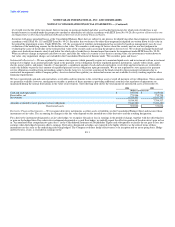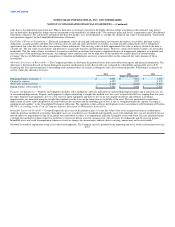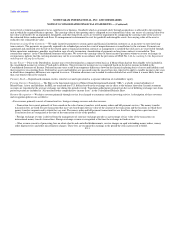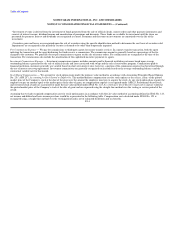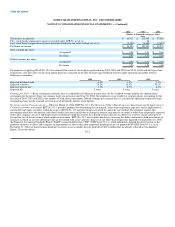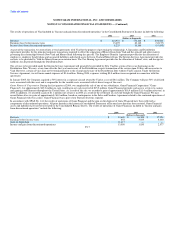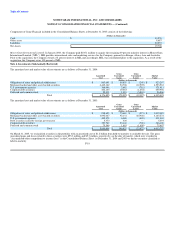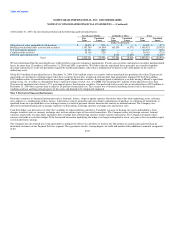MoneyGram 2004 Annual Report Download - page 56
Download and view the complete annual report
Please find page 56 of the 2004 MoneyGram annual report below. You can navigate through the pages in the report by either clicking on the pages listed below, or by using the keyword search tool below to find specific information within the annual report.
Table of Contents
MONEYGRAM INTERNATIONAL, INC. AND SUBSIDIARIES
NOTES TO CONSOLIDATED FINANCIAL STATEMENTS — (Continued)
same line as the underlying transaction risk. When a derivative is no longer expected to be highly effective, hedge accounting is discontinued. Any gain or
loss on derivatives designated as hedges that are terminated or discontinued is recorded in the "Net securities gains and losses" component in the Consolidated
Statements of Income. For a derivative instrument that does not qualify, or is not designated, as a hedge, the change in fair value is recognized in "Transaction
and operations support" in the Consolidated Statements of Income.
Fair Value of Financial Instruments — Financial instruments consist of cash and cash equivalents, investments, derivatives, receivables, payment service
obligations, accounts payable and debt. The carrying values of cash and cash equivalents, receivables, accounts payable and payment service obligations
approximate fair value due to the short-term nature of these instruments. The carrying values of debt approximate fair value as interest related to the debt is
variable rate. The fair value of investments and derivatives is generally based on quoted market prices. However, certain investment securities are not readily
marketable. The fair value of these investments is based on cash flow projections that require a significant degree of management judgment as to default and
recovery rates of the underlying investments. Accordingly, these estimates may not be indicative of the amounts we could realize in a current market
exchange. The use of different market assumptions or valuation methodologies may have a material effect on the estimated fair value amounts of these
investments.
Allowance for Losses on Receivables — The Company provides an allowance for potential losses from receivables from agents and financial institutions. The
allowance is determined based on known delinquent accounts and historical trends. Receivables are evaluated for collectibility and possible write-off by
examining the facts and circumstances surrounding each customer where an account is delinquent and a loss is deemed possible. Following is a summary of
activity within the allowance for losses:
2004 2003 2002
(Dollars in thousands)
Beginning balance at January 1, $ 6,968 $ 7,863 $ 7,850
Charged to expense 6,422 3,987 5,932
Write-offs, net of recoveries (5,460) (4,882) (5,919)
Ending balance at December 31, $ 7,930 $ 6,968 $ 7,863
Property and Equipment — Property and equipment includes office equipment, software and hardware and leasehold improvements and is stated at cost, net
of accumulated depreciation. Property and equipment is depreciated using a straight-line method over the assets' estimated useful lives ranging from ten years
for office furniture and equipment, five to seven years for agent equipment and three to five years for computer hardware and software. Leasehold
improvements are amortized using the straight-line method over the lesser of the lease term or useful life of the asset. The cost and related accumulated
depreciation of assets sold or disposed of are removed from the accounts and the resulting gain or loss, if any, is recognized under the caption "Occupancy,
equipment and supplies" in the Consolidated Statement of Income. We capitalize certain software development costs in accordance with Statement of Position
No. 98-1, Accounting for the Costs of Computer Software Developed or Obtained for Internal Use.
Intangible Assets and Goodwill — Goodwill represents the excess of the purchase price over the fair value of net assets acquired in business combinations
under the purchase method of accounting. Intangible assets are recorded at cost. Goodwill and intangible assets with indefinite lives are not amortized, but are
instead subject to impairment testing on an annual basis and whenever there is an impairment indicator. Intangible assets with finite lives are amortized using
a straight-line method over their respective useful lives of seven to fifteen years for customer lists, 36 to 40 years for trademarks and 24 years for patents.
Intangible assets are tested for impairment whenever events or changes in circumstances indicate that its carrying amount may not be recoverable.
Goodwill is tested for impairment using a fair-value based approach. The Company assesses goodwill at the reporting unit level, which is determined to be the
F-12


